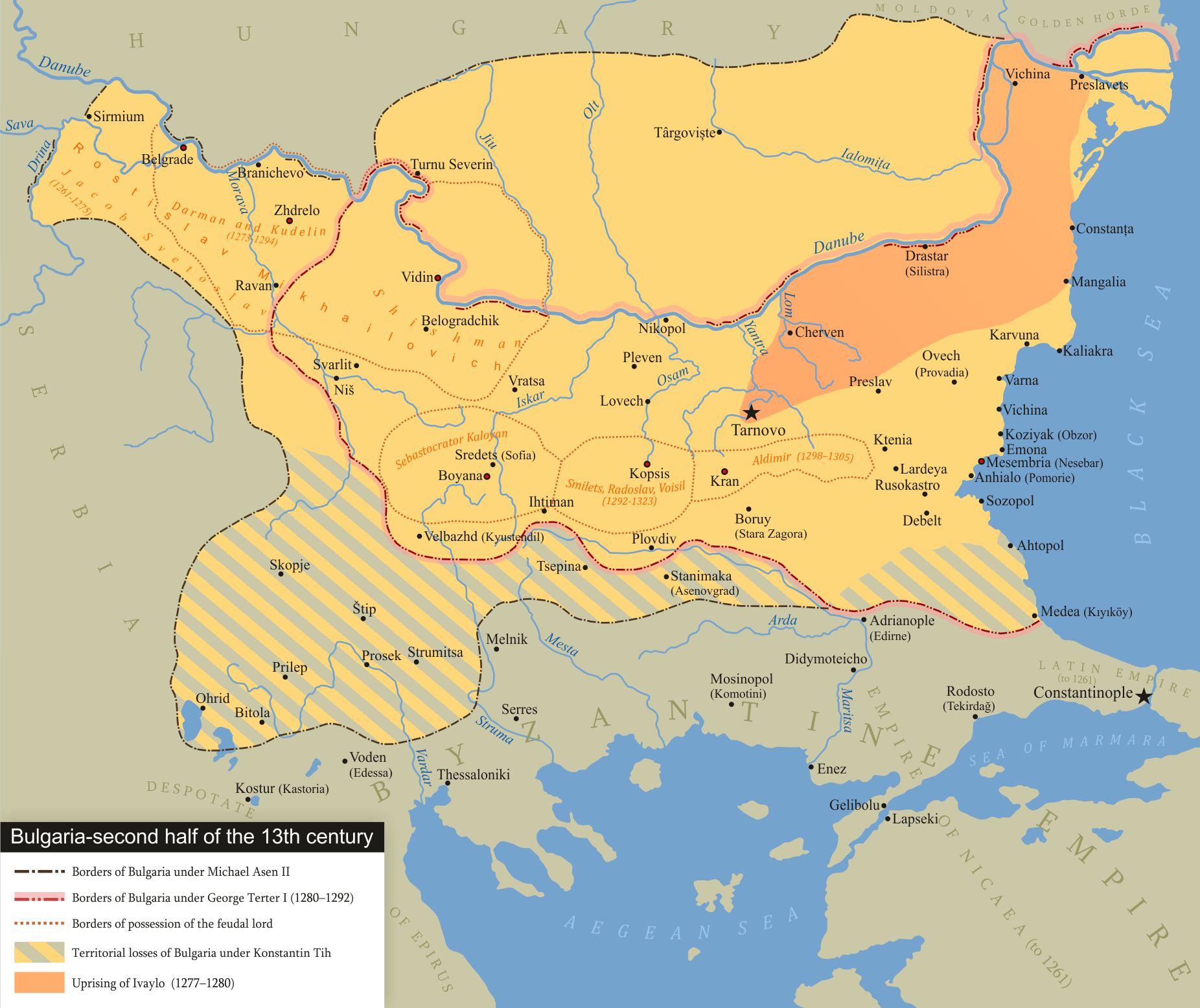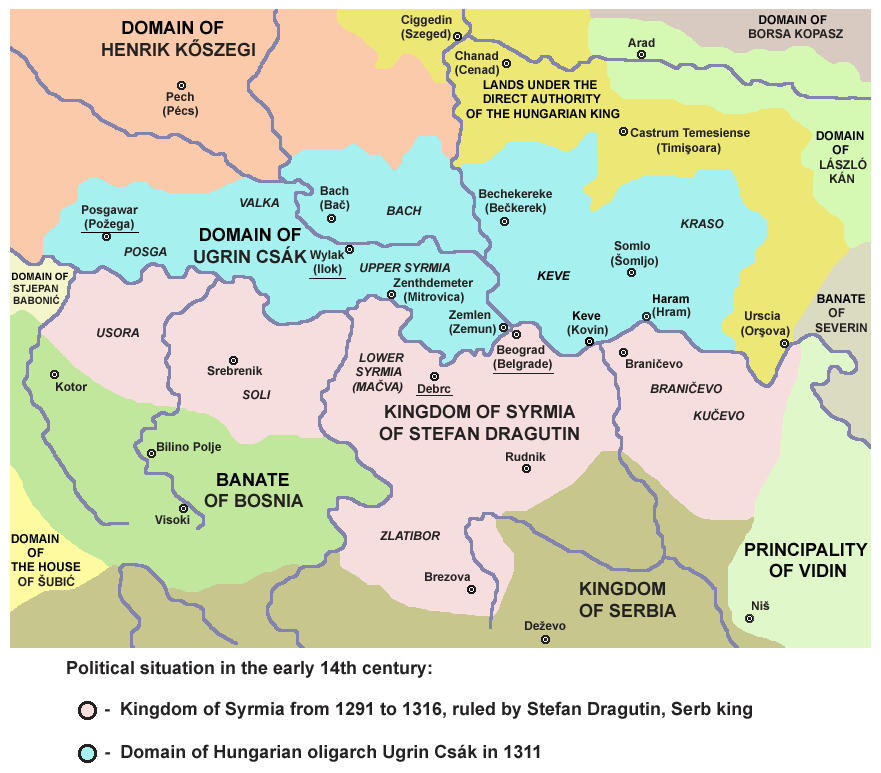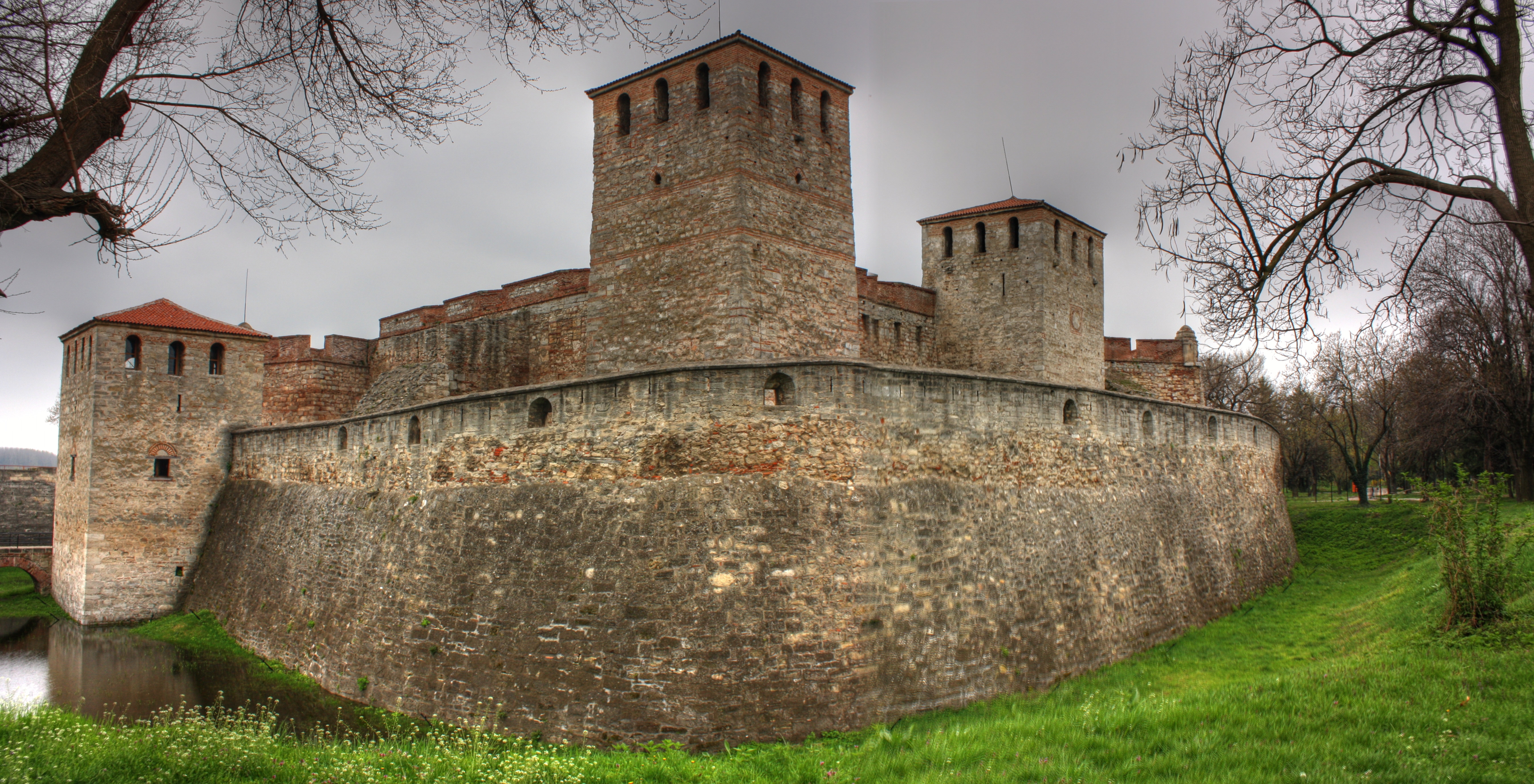|
Darman And Kudelin
Darman ( bg, Дърман; also ''Drman'', ''Dǎrman'', ''Durman'', ''Dorman'') and Kudelin ( bg, Куделин) were two Bulgarian boyars of Cuman origin who jointly ruled the regions of Braničevo and Kučevo (in modern Serbia) in the late 13th century (1273–1291). The two brothers used the weakened state of centralized administration in the region to become independent from the Kingdom of Hungary or the Second Bulgarian Empire in 1273. The capital of their domains was the fortress of Ždrelo, on the Mlava river. Relying on auxiliary troops that consisted mostly of Tatar and Cuman mercenaries, the brothers were “very independent-minded and afraid of no one”, according to Serbian archbishop Danilo II. They regularly attacked their western neighbour, the Hungarian vassal Stefan Dragutin's Syrmian Kingdom, in Mačva, an area previously under the sovereignty of Elizabeth of Hungary. The Hungarian queen had sent troops to claim Braničevo in 1282–1284, but her forces wer ... [...More Info...] [...Related Items...] OR: [Wikipedia] [Google] [Baidu] |
Mačva
Mačva ( sr-Cyrl, Мачва, ; hu, Macsó) is a geographical and historical region in the northwest of Central Serbia, on a fertile plain between the Sava and Drina rivers. The chief town is Šabac. The modern Mačva District of Serbia is named after the region, although the region of Mačva includes only the northern part of this district. A small northern part of Mačva region is in the Autonomous Province of Vojvodina, in the Syrmia District. Name The region is named after a town of Mačva, which existed in the Medieval Ages near the river Sava. In the past, the region was also known as ''Lower Srem'', while the neighbouring region on the northern bank of the river Sava (present-day Srem) was known as ''Upper Srem''. In Serbian Cyrillic, the region is known as Мачва, in Serbian Latin, Bosnian and Croatian as ''Mačva'', in Hungarian as ''Macsó'' or ''Macsóság'', in Turkish as ''Maçva'', and in German as ''Matschva''. History Throughout history, the region of M ... [...More Info...] [...Related Items...] OR: [Wikipedia] [Google] [Baidu] |
Medieval Bulgarian Military Personnel
In the history of Europe, the Middle Ages or medieval period lasted approximately from the late 5th to the late 15th centuries, similar to the post-classical period of global history. It began with the fall of the Western Roman Empire and transitioned into the Renaissance and the Age of Discovery. The Middle Ages is the middle period of the three traditional divisions of Western history: classical antiquity, the medieval period, and the modern period. The medieval period is itself subdivided into the Early, High, and Late Middle Ages. Population decline, counterurbanisation, the collapse of centralized authority, invasions, and mass migrations of tribes, which had begun in late antiquity, continued into the Early Middle Ages. The large-scale movements of the Migration Period, including various Germanic peoples, formed new kingdoms in what remained of the Western Roman Empire. In the 7th century, North Africa and the Middle East—most recently part of the Eastern Roman ... [...More Info...] [...Related Items...] OR: [Wikipedia] [Google] [Baidu] |
13th-century Bulgarian People
The 13th century was the century which lasted from January 1, 1201 ( MCCI) through December 31, 1300 ( MCCC) in accordance with the Julian calendar. The Mongol Empire was founded by Genghis Khan, which stretched from Eastern Asia to Eastern Europe. The conquests of Hulagu Khan and other Mongol invasions changed the course of the Muslim world, most notably the Siege of Baghdad (1258), the destruction of the House of Wisdom and the weakening of the Mamluks and Rums which, according to historians, caused the decline of the Islamic Golden Age. Other Muslim powers such as the Mali Empire and Delhi Sultanate conquered large parts of West Africa and the Indian subcontinent, while Buddhism witnessed a decline through the conquest led by Bakhtiyar Khilji. The Southern Song dynasty would begin the century as a prosperous kingdom but would eventually be invaded and annexed into the Yuan dynasty of the Mongols. The Kamakura Shogunate of Japan would be invaded by the Mongols. Go ... [...More Info...] [...Related Items...] OR: [Wikipedia] [Google] [Baidu] |
Medieval Bulgarian Nobility
In the history of Europe, the Middle Ages or medieval period lasted approximately from the late 5th to the late 15th centuries, similar to the Post-classical, post-classical period of World history (field), global history. It began with the fall of the Western Roman Empire and transitioned into the Renaissance and the Age of Discovery. The Middle Ages is the middle period of the three traditional divisions of Western history: classical antiquity, the medieval period, and the modern history, modern period. The medieval period is itself subdivided into the Early Middle Ages, Early, High Middle Ages, High, and Late Middle Ages. Population decline, counterurbanisation, the collapse of centralized authority, invasions, and mass migrations of tribes, which had begun in late antiquity, continued into the Early Middle Ages. The large-scale movements of the Migration Period, including various Germanic peoples, formed new kingdoms in what remained of the Western Roman Empire. In the ... [...More Info...] [...Related Items...] OR: [Wikipedia] [Google] [Baidu] |
House Of Shishman
The House of Shishman ( bg, Шишман), also Shishmanids or Shishmanovtsi ( bg, Шишмановци), was a medieval Bulgarian royal dynasty of Cuman (or partial Cuman) origin. The Shishman dynasty consecutively ruled the Second Bulgarian Empire for approximately one century, from 1323 to 1422, until it was conquered by the Ottomans. The Shishmanids were related to the earlier Asen dynasty, and according to the Ragusan historian Lukarić, also to the immediately preceding Terter dynasty. In Plamen Pavlov's view, the Shishman dynasty's founder, despot Shishman of Vidin, may have been the brother of George I, the first Bulgarian Terterid ruler, thus also coming to Bulgaria from the Kingdom of Hungary after 1241. Members Among its more notable members were: Main branch: * despot Shishman of Vidin :* Michael Shishman of Bulgaria (Michael Asen III) (b. after 1280, ruled 1323–1330) ::* Ivan Stephen of Bulgaria (ruled 1330–1331) :*despot Belaur of Vidin (d. 1336) Srats ... [...More Info...] [...Related Items...] OR: [Wikipedia] [Google] [Baidu] |
Shishman Of Vidin
Shishman ( bg, Шишман; 1270s/1280s — before 1308/1313) was a Second Bulgarian Empire, Bulgarian nobleman (boyar) who ruled a semi-independent realm based out of the Danube, Danubian fortress of Vidin in the late 13th and early 14th century. Shishman, who was bestowed the title of "despot (court title), despot" by Bulgarian emperor George I of Bulgaria, George Terter I, was a Cumans, Cuman, and may have been established as lord of Vidin as early as the 1270s. In 1291, he came under Golden Horde ("Tatar") suzerainty and in 1292 he was in charge of an unsuccessful campaign against neighbouring Kingdom of Serbia (medieval), Serbia. Even though the Serbs captured Vidin in their counter-offensive, perhaps thanks to Tatar influence Shishman was placed once more as the ruler of the region, this time as a Serbian vassal. However, he continued to rule his lands largely independently. As his son and successor as despot of Vidin Michael Shishman of Bulgaria, Michael Shishman ac ... [...More Info...] [...Related Items...] OR: [Wikipedia] [Google] [Baidu] |
Serbs
The Serbs ( sr-Cyr, Срби, Srbi, ) are the most numerous South Slavic ethnic group native to the Balkans in Southeastern Europe, who share a common Serbian ancestry, culture, history and language. The majority of Serbs live in their nation state of Serbia, as well as in Bosnia and Herzegovina, Croatia, Montenegro, and Kosovo. They also form significant minorities in North Macedonia and Slovenia. There is a large Serb diaspora in Western Europe, and outside Europe and there are significant communities in North America and Australia. The Serbs share many cultural traits with the rest of the peoples of Southeast Europe. They are predominantly Eastern Orthodox Christians by religion. The Serbian language (a standardized version of Serbo-Croatian) is official in Serbia, co-official in Kosovo and Bosnia and Herzegovina, and is spoken by the plurality in Montenegro. Ethnology The identity of Serbs is rooted in Eastern Orthodoxy and traditions. In the 19th century ... [...More Info...] [...Related Items...] OR: [Wikipedia] [Google] [Baidu] |
Stefan Uroš II Milutin Of Serbia
Stefan Uroš II Milutin ( sr-cyr, Стефан Урош II Милутин, Stefan Uroš II Milutin; 1253 – 29 October 1321), known as Stefan Milutin ( sr-cyr, Стефан Милутин, Stefan Milutin), was the King of Serbia between 1282–1321, a member of the Nemanjić dynasty. He was one of the most powerful rulers of Serbia in the Middle Ages. Milutin is credited with strongly resisting the efforts of Byzantine Emperor Michael VIII Palaiologos to impose Roman Catholicism on the Balkans after the Union of Lyons in 1274. During his reign, Serbian economic power grew rapidly, mostly due to the development of mining. He founded Novo Brdo, which became an internationally important silver mining site. As most of the Nemanjić monarchs, he was proclaimed a saint by the Serbian Orthodox Church with a feast day on October 30. Milutin appears in the Dante Alighieri's narrative poem ''Divine Comedy''. Early life He was the youngest son of King Stefan Uroš I and his wife, ... [...More Info...] [...Related Items...] OR: [Wikipedia] [Google] [Baidu] |
Sava
The Sava (; , ; sr-cyr, Сава, hu, Száva) is a river in Central and Southeast Europe, a right-bank and the longest tributary of the Danube. It flows through Slovenia, Croatia and along its border with Bosnia and Herzegovina, and finally through Serbia, feeding into the Danube in its capital, Belgrade. The Sava forms the main northern limit of the Balkan Peninsula, and the southern edge of the Pannonian Plain. The Sava is long, including the Sava Dolinka headwater rising in Zelenci, Slovenia. It is the largest tributary of the Danube by volume of water, and second-largest after the Tisza in terms of catchment area () and length. It drains a significant portion of the Dinaric Alps region, through the major tributaries of Drina, Bosna, Kupa, Una, Vrbas, Lonja, Kolubara, Bosut and Krka. The Sava is one of the longest rivers in Europe and among the longest tributaries of another river. The population in the Sava River basin is estimated at 8,176,000, and is ... [...More Info...] [...Related Items...] OR: [Wikipedia] [Google] [Baidu] |
Nogai Khan
Nogai, or Noğay (; also spelled Nogay, Nogaj, Nohai, Nokhai, Noqai, Ngoche, Noche, Kara Nokhai, and Isa Nogai; died 1299/1300) was a general and kingmaker of the Golden Horde and a great-great-grandson of Genghis Khan. His grandfather was Bo'al/Baul/Teval, the seventh son of Jochi. Nogai was also a notable convert to Islam. Though he never formally ruled the Golden Horde himself, he was effectively the co-ruler of the state alongside whatever khan was in power at the time and had unrestricted control over the portions west of the Dnieper. At his height, Nogai was one of the most powerful men in Europe and widely thought of as the Horde's true head. The Russian chroniclers gave him the title of tsar, and the Franciscan missionaries in the Crimea spoke of him as a co-emperor. Name French historian Paul Pelliot wrote that Nokhai meant "dog". Although in the Mongolian language, "nokhoi" (in Mongolian script: , ''nokhai'') literally means a "dog", it does not necessarily mean a parti ... [...More Info...] [...Related Items...] OR: [Wikipedia] [Google] [Baidu] |
Wallachian Plain
The Romanian Plain ( ro, Câmpia Română) is located in southern Romania and the easternmost tip of Serbia, where it is known as the Wallachian Plain ( sr, Vlaška nizija/Влашка низија). Part of the historical region of Wallachia, it is bordered by the Danube River in the east, south and west, and by the in the north. Bucharest, the capital of Romania, is located in the central part of the Romanian Plain. It is contiguous to the south with the Danubian Plain ( bg, Дунавска равнина), in Bulgaria. This area is also sometimes referred to as the Danubian Plain ''(Câmpia Dunării)'' in Romanian, though this designation is not specific, because the Danube flows through a number of plains along its course, such as the Hungarian Plain (which is called the Danubian Plain in Slovakia and Serbia), as well as the Bavarian Lowland, also called the Danubian Plain. Subdivisions In Romania, the plain is divided into five subdivisions and the Danube Valley, which a ... [...More Info...] [...Related Items...] OR: [Wikipedia] [Google] [Baidu] |





.png)


.jpeg/1200px-Bataille_du_Terek_(1262).jpeg)